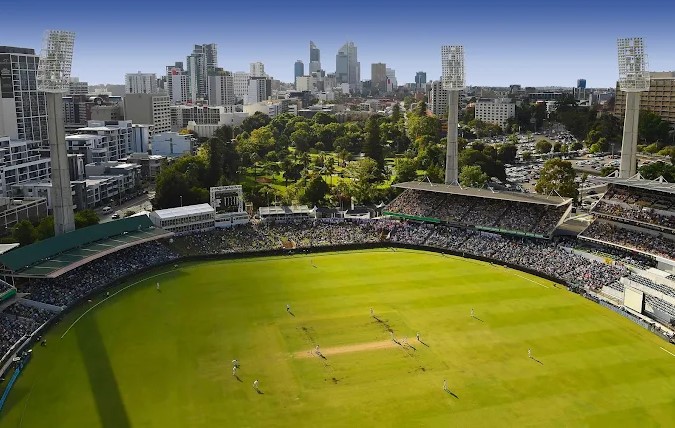Cricket grounds around the world vary in size, and boundary lengths play a vital role in influencing the game’s dynamics. The Perth Cricket Ground, more famously known as Optus Stadium since its inauguration in 2018, has emerged as a significant venue in international and domestic cricket. Understanding its boundary dimensions gives insights into strategy, pitch behavior, and how it compares to other grounds globally.
Overview of the Perth Cricket Ground (Optus Stadium)
Optus Stadium is located in Burswood, just east of Perth’s central business district in Western Australia. Opened in January 2018, the stadium replaced the historic WACA Ground as Perth’s primary cricket venue. With a seating capacity of over 60,000, it is among the largest stadiums in Australia.
While the stadium is multipurpose and hosts Australian Rules Football (AFL), rugby, concerts, and more, it has quickly become known for its lively pitch and unique boundary configuration in cricketing circles.
Importance of Boundary Dimensions in Cricket
Boundary dimensions are essential for several reasons:
- Batting Strategy: Shorter boundaries encourage big hitting.
- Bowling Tactics: Bowlers adjust line and length based on boundary size.
- Spectator Experience: Frequent sixes make for a thrilling match atmosphere.
- Ground Comparison: It allows comparisons of batting records across different venues.
Perth Cricket Ground Boundary Dimensions
The boundary lengths at Optus Stadium vary due to its oval shape. The ground does not have a uniform diameter, and the playing area is slightly larger than many other Australian venues.
Typical Boundary Lengths at Perth Cricket Ground (Optus Stadium)
| Direction | Boundary Length (approx.) |
|---|---|
| Straight (north-south) | 75 – 80 meters |
| Square (east-west) | 65 – 70 meters |
| Longest boundary | ~82 meters |
| Shortest boundary | ~63 meters |
| Ground Shape | Oval |
The playing area has generous straight boundaries, making six-hitting down the ground more challenging than at venues with shorter straights. However, the square boundaries are slightly shorter, allowing for horizontal bat shots such as cuts and pulls to be more productive.
Comparison with Other Australian Grounds
To better understand how Perth’s boundary dimensions stack up, here’s a comparative table:
Comparison of Boundary Lengths Across Major Australian Cricket Grounds
| Ground | Straight (m) | Square (m) | Area Shape | Comment |
|---|---|---|---|---|
| Optus Stadium (Perth) | 75–80 | 65–70 | Oval | Bouncy pitch; spacious straights |
| MCG (Melbourne) | 74–78 | 86–90 | Circular | Huge square boundaries |
| SCG (Sydney) | 62–68 | 67–74 | Irregular | Smaller, spinner-friendly |
| Gabba (Brisbane) | 70–75 | 65–70 | Oval | Fast pitch, even dimensions |
| Adelaide Oval | 64–69 | 83–88 | Oval | Short straights, long square |
From the table, it’s evident that Optus Stadium has relatively longer straight boundaries but shorter square ones compared to the MCG or Adelaide Oval. This directly affects the nature of scoring and bowling performances.
Historical Context: From WACA to Optus Stadium
Before Optus Stadium, the WACA Ground was synonymous with Perth cricket. Known for its extreme pace and bounce, the WACA had a much smaller playing area.
WACA Ground vs Optus Stadium
| Feature | WACA Ground | Optus Stadium |
|---|---|---|
| Straight boundary (m) | 60–65 | 75–80 |
| Square boundary (m) | 60–65 | 65–70 |
| Total capacity | ~24,500 | ~60,000 |
| Usage today | Limited cricket | Main Perth venue |
| Pitch characteristics | Bouncy, dry | Bouncy, modern turf |
Optus Stadium maintains some of the fast-bowling character of the WACA but introduces a more spacious field, making high scoring slightly tougher unless batsmen adapt well.
Impact of Boundary Length on Match Outcomes
1. Batsmen’s Tactics
Big-hitters such as Glenn Maxwell or David Warner often aim square boundaries in Perth due to the longer straights. This shifts focus from the classical straight drives to powerful cuts and sweeps.
2. Bowler-Friendly Ground?
3. Fielding and Game Strategy
Captains adjust field placements significantly at Perth. Fielders patrolling the boundary must cover more ground, especially straight, while spinners have to bowl wider lines to use the shorter square dimensions cautiously.
Memorable Matches and Performances at Optus Stadium
Despite being a newer venue, Optus Stadium has already witnessed a few iconic matches:
- Australia vs India (2018): Fast bowlers dominated on a lively pitch with long boundaries punishing mishits.
- BBL Matches: Perth Scorchers enjoy a strong home advantage thanks to the combination of a pacy pitch and challenging boundary sizes.
- 2022 T20 World Cup: The long boundaries tested teams unfamiliar with the ground’s dimensions, often resulting in low-scoring thrillers.
Sample Team Scores at Optus Stadium (T20 Internationals)
| Match | Total Score | Result |
|---|---|---|
| Australia vs Pakistan (2022) | 154/7 | Australia won by 8 runs |
| England vs Afghanistan (2022) | 112/5 | England won by 5 wickets |
| India vs South Africa (2022) | 133/9 | South Africa won by 5 wickets |
These scores reflect the challenging nature of scoring at Perth when boundaries aren’t short and when bowlers use bounce effectively.
Challenges and Innovations
With the variability in boundary sizes:
- Technology like ball-tracking and AI fielding maps are now used to optimize player positions.
- Drone-based footage allows broadcasters to showcase how a boundary size influences a catch or six.
- The ICC standard recommends boundaries to be a minimum of 59.43 meters (65 yards) from the center of the pitch, but venues like Perth often exceed this.
The Perth Cricket Ground (Optus Stadium) offers a unique combination of long straight boundaries and moderate square ones, distinguishing it from other global venues. These dimensions, combined with a hard and bouncy pitch, make Perth a paradise for fast bowlers and a strategic challenge for batsmen. Understanding the boundary configuration is essential for players, analysts, and fans to appreciate the game’s nuances at this iconic Australian venue.
As cricket evolves with formats like T20, boundary lengths like those at Optus Stadium ensure a balance between bat and ball, keeping the spirit and competitiveness of the game intact.


